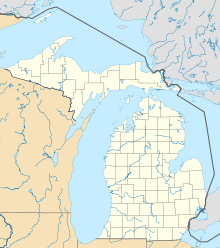Mohawk Mine
| Location | |
|---|---|
| state/province | Michigan |
| Country | United States |
| Coordinates | 47°18′29″N 88°21′20″W / 47.30806°N 88.35556°WCoordinates: 47°18′29″N 88°21′20″W / 47.30806°N 88.35556°W |
| Production | |
| Products | Copper |
| History | |
| Opened | 1898 |
| Closed | 1932 |
The Mohawk Mining Company was a major copper mining company, based in the Keweenaw Peninsula of Michigan, that was established in November 1898 and lasted until 1932. The company, between 1906 and 1932, paid out more than $15 million in shareholder dividends. The Mine is best known for the large amounts of mohawkite that were found on the property. The Mohawk mine operated until 1932; in 1934 it was purchased by the Copper Range Company.
The property was originally considered too far east to contain valuable ore deposits. It was first considered a mining location in 1896, after lumberman Ernest Koch first discovered copper there. The company was later established in November 1898, after Joseph E. Gay had conducted a successful exploration for copper on the property earlier that year. When established, John Stanton was president. Stocks were offered at a price $7.50, and by the end of 1899 there were 594 individual stockholders. In 1899, construction on the property began, after the company had raised $7,517.50. Shafts No. 1, No. 2, and No. 3 were dug. Each shaft had three compartments with two skiproads, and a separate pipe and ladder way compartment. Shaft No. 2 had an 8 drill air compressor and No. 3 had a 25 drill air compressor. Both were Ingersoll Sergeant make, with Rand drills for underground use. A fourth shaft was constructed in 1901.
In January 1900, a fissure vein of copper ore was cut on the first level of Shaft No. 1. This ore was a previously unknown type of rock and samples were sent to George A. Koenig of the Michigan College of Mines. Koenig named the rock mohawkite for the mine where it had been found.
In the year 1900, the Mohawk Mining Company purchased the Hebard Stone Quarry, the dock on Traverse Bay, and the narrow gauge railroad connecting the dock and the quarry. The railway was extended from the quarry to the mine. The dock was extended 300 feet into the bay and was reinforced with heavy crib-work, so that it could be used for shipping ore and receiving supplies by boat. In 1902, the Mohawk and Traverse Bay Railroad was widened to regular gage.
The Mohawk stamp mill began construction in 1901 and started operation in December 1902. The foundation for the 178 by 206 foot building, of steel frame covered with corrugated iron, was made of sandstone from the Hebard Quarry. The mill's equipment included three sets of stamps and three sets of auxiliary crushing rolls. The stamps each had a capacity of 500 tons daily. Four houses and a large two story building were built near the mill. The two story structure was to be used as a school on the first floor and a meeting room on the second. This settlement later became the town of Gay and was named Gay to honor Joseph E. Gay.
...
Wikipedia

